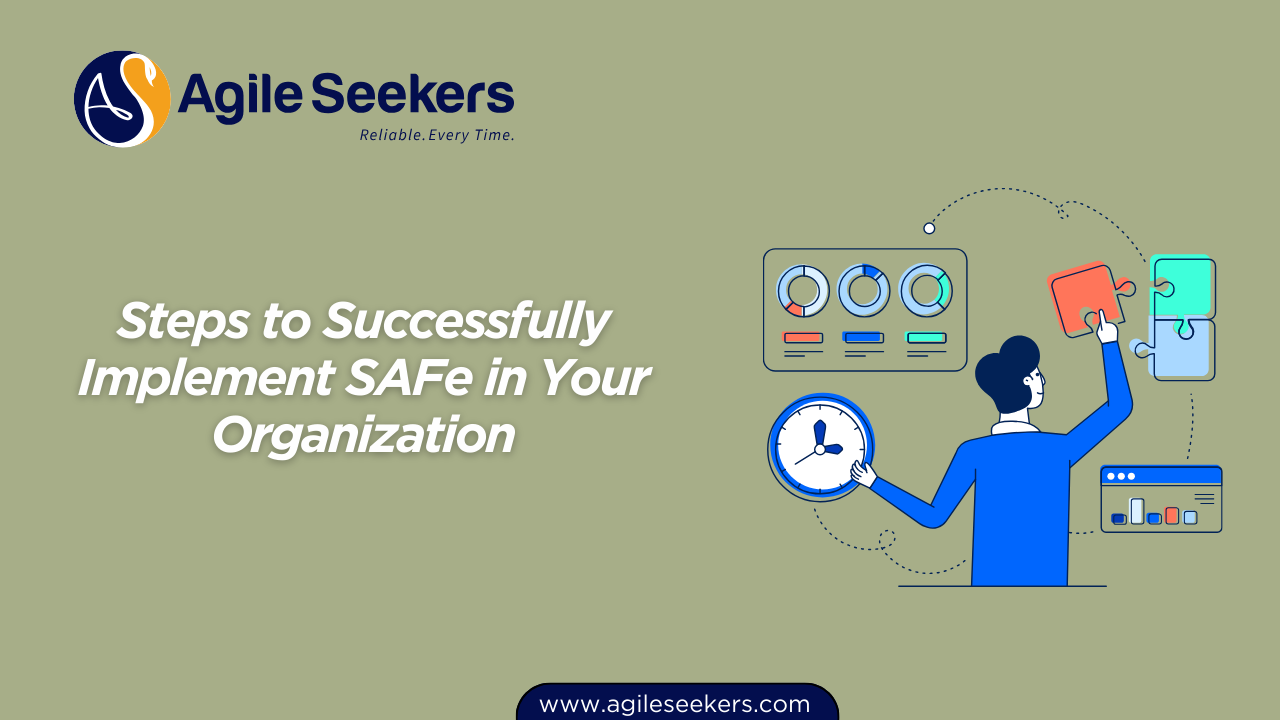Steps to Successfully Implement SAFe in Your Organization

Before you touch a framework or schedule a training, get clear about why you’re considering SAFe. Is it market pressure? Internal chaos? Quality drops? SAFe isn’t a magic fix. It’s a way to address complex problems, but only if everyone knows what you’re actually trying to solve.
2. Get Executive Buy-In and Active Participation
You can’t “roll out SAFe” from the bottom up. You need visible support from the top. Executives should do more than sign off—they should understand Lean-Agile leadership, actively sponsor change, and set the tone for the journey.
If you want executives to truly understand what’s required, encourage them to complete Leading SAFe Agilist Certification Training. This helps leaders see beyond buzzwords and focus on enabling value flow.
3. Build a Lean-Agile Leadership Coalition
Create a small team of influential leaders, coaches, and respected delivery experts to guide the transformation. This coalition isn’t about titles—it’s about having the right mix of authority, hands-on experience, and change skills. They’ll remove blockers, clarify intent, and reinforce principles.
4. Assess the Current State—and Be Honest
You need a clear-eyed view of where you’re starting. Map your value streams, look at delivery bottlenecks, and pinpoint organizational silos. Use practical tools like a value stream mapping workshop or SAFe’s self-assessment checklists.
Pro tip: Don’t fudge this step. Glossing over pain points means you’ll solve the wrong problems.
5. Communicate the ‘Why’, ‘What’, and ‘How’ Early and Often
People resist change when they don’t understand it. Make it clear what SAFe is, why you’re adopting it, and how it will affect real teams. Use all-hands meetings, town halls, and direct Q&A sessions—not just email blasts.
6. Train Everyone—Not Just the Scrum Masters
Training isn’t a checkbox. You want cross-functional teams who understand their new roles. That includes business owners, developers, testers, and of course, Scrum Masters and Product Owners. The SAFe Product Owner/Product Manager (POPM) Certification is especially valuable here, as it sharpens the product mindset.
Scrum Masters should level up too, with SAFe Scrum Master Certification. This ensures your facilitators can handle both team and cross-team complexity.
7. Design Your First Agile Release Train (ART)
Think of the ART as your engine for change. Identify 50–125 people who work together to deliver value. Structure your ART around a real value stream—not just reporting lines or departments. Make sure leadership is on board with this “slice” of the org.
Selecting the right Release Train Engineer (RTE) is critical. The SAFe Release Train Engineer Certification Training provides the practical knowledge needed to steer your ART through turbulence.
8. Prepare the Backlog—And Make It Transparent
You can’t build what you can’t see. Bring together business and technology leaders to build a clear, prioritized backlog. Make sure everyone understands the distinction between features, capabilities, and epics. Use a tool that supports visibility, not just ticket tracking.
9. Run the First Program Increment (PI) Planning
This is where theory meets reality. Bring all ART members into a shared, time-boxed planning event. Set real objectives, expose dependencies, and agree on what “done” looks like. This is the heartbeat of SAFe.
Here’s the thing: PI Planning will probably feel chaotic at first. That’s normal. Embrace the mess, capture lessons learned, and improve with every cycle.
10. Coach, Observe, and Adjust
Once you’re rolling, the work shifts to coaching, reinforcing new habits, and making targeted improvements. SAFe Advanced Scrum Master Certification Training can help experienced Scrum Masters navigate system-level challenges and coach teams beyond the basics.
Retrospectives and Inspect & Adapt workshops keep the feedback loop alive. Use data—throughput, quality, predictability—to spot trends and guide your next moves.
11. Expand, Don’t Overreach
Nail it with your first ART before scaling out. Once you have proof of success, use those lessons to launch additional ARTs. Scale deliberately—don’t let enthusiasm turn into chaos.
12. Connect SAFe with Broader Business Agility
Remember, SAFe isn’t the goal. Business agility is. Keep the focus on delivering value to customers and adapting to change. This mindset helps the transformation stick.
Practical Tips to Avoid Pitfalls
-
Don’t treat SAFe as a silver bullet. It won’t fix unclear strategy or broken leadership.
-
Focus on outcomes, not outputs. Celebrate impact, not story points.
-
Invest in ongoing learning. Certifications help, but so does experience. Pair formal learning with mentoring and hands-on support.
-
Keep leadership engaged. When leaders drift away, so does momentum.
-
Leverage community resources. The Scaled Agile Framework Implementation Roadmap offers field-tested guidance.
-
Pay attention to cultural blockers. Old-school management habits will slow you down if you ignore them.
Making the Change Stick
Successful SAFe implementation is about consistency and learning. Organizations that make SAFe work are the ones that keep asking, “Is this helping us deliver value?” They’re not afraid to tweak the process or call out what isn’t working. Over time, you’ll see faster delivery, tighter alignment, and better results.
For anyone ready to start or accelerate this journey, getting the right mix of certified leaders, practical training, and hands-on support is key. Look at recognized programs like Leading SAFe Agilist Certification Training, SAFe Product Owner/Product Manager POPM Certification, and SAFe Scrum Master Certification to build that capability.
Also read - Turning Feedback into Results in SAFe Framework
Also see - How to Build a Strong Foundation for SAFe Transformation




















